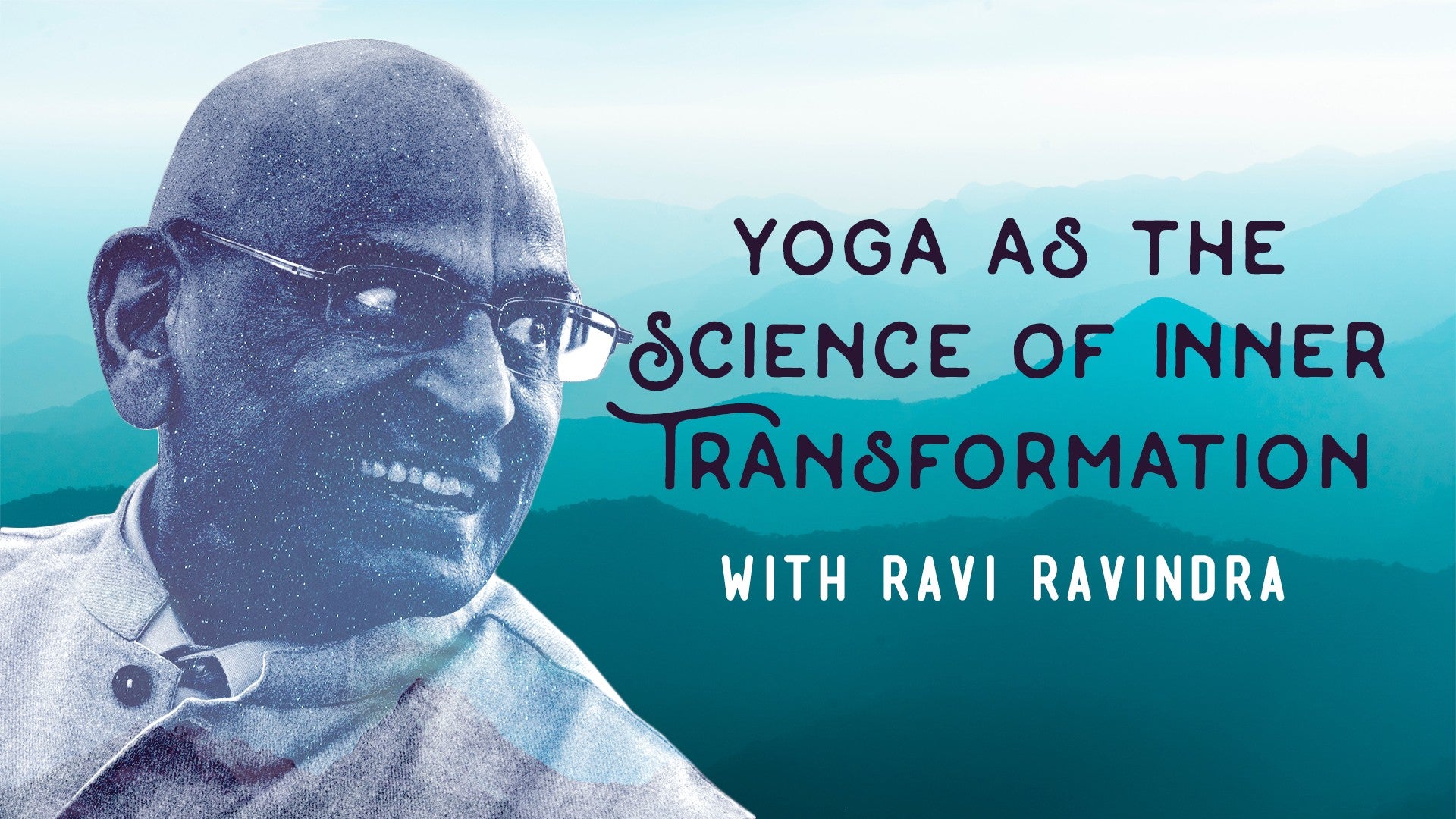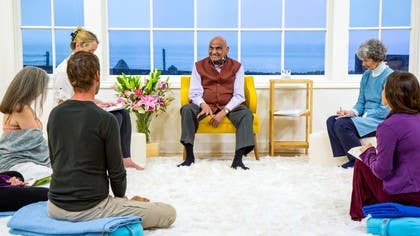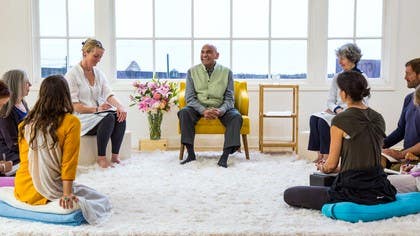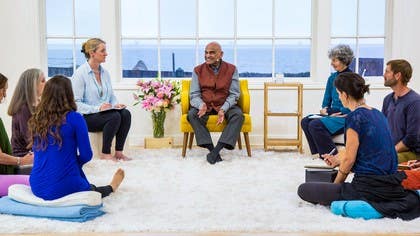Description
About This Video
Transcript
Read Full Transcript
Chapter 1
Again, it's always helpful to take a moment to find our relaxation and the right alignment and contact with our breath. Then we will try in this meditation to understand a universal idea, but to see if I can find this in practice to see it, that we have a spiritual nature and an animal nature, or sometimes labeled higher nature, lower nature. To begin with, even completely mentally, I ask myself, how do I approach the idea of having a spiritual nature without arguing with oneself, just wondering if something in me calls me to serve something other than my own interests or my family's interests? Having any event, any person, any teaching that evokes in me a feeling for being of service to something other than myself. Because according to the various sages, this is an aspect or a characteristic of our spiritual nature.On the other side, not to be against it, but impartially to watch. Any aspect of myself or, for example, self-improvement, self-assertion, my idea, my understanding, my understanding of myself, my understanding of myself, my understanding of myself, my understanding of myself, my understanding of myself, my understanding of myself, my understanding of myself, my understanding of myself, my understanding of myself, my understanding of myself. And I internally use just this expression to watch where it resonates in my body, in my head or chest or wherever else it resonates. I know what I am doing, just to use the words only two or three times, but more importantly to try to see what the feeling is behind it and what is actually the place in the organism where it resonates. I know what I am doing.
And then I let go of these words and just to pay a little attention to simply breathing in and breathing out so that as if I am cleansing my mind. Now, I internally, three or four times, use this expression and watch where it resonates in me, biologically, physically, but more importantly, what is the feeling behind it? So, I say, I wonder what I am called to do. I wonder what I am called to do. Again, I simply pay some attention to breathing in and breathing out.
It sort of clears my mind. So, I say, I know what I am called to do, but more importantly, I say, I know what I am called to do. Now again, at my own tempo, same words if possible, or if you wish to change the words, but more importantly, wishing to approach, to understand how do I find both of these natures, not to be against either, but what is their relationship with each other? The animal nature is also needed, very much the care of the body, its health, a simple reminder from the great traditions that the body is the temple of the spirit, so the temple is also needed to be taken care of, but why? Why?
I know what I am doing. I wonder what I am called to do. I know what I am called to do, but I know what I am called to do, so I know what I am called to do. Then I return again to simply breathing in and breathing out. And if I feel a sense of gratitude for the fact that I am able to breathe in and breathe out and remain alive.
Thank you. Thank you.
Chapter 2
As a part of our looking at yoga as a whole science of transformation, it is good to just glance at the eight limbs of yoga that the yoga sutra speaks about. And in fact the first two are usually ignored in most yoga teacher training courses, so I would a little bit want to focus on it, because they are very much connected with really a whole internal understanding of where we stand. So let me just quickly mention, most of you of course know that, the eight limbs are yam niyam asana pranayama pratyahar, these five are regarded as more or less external limbs compared with the other three, which are more internal, dharana dhyana samadhi.So these are the eight limbs. First of all to make a general remark, of course, naturally when we are expressing eight items there is a kind of a linearity, but it is not that until I wholly accomplish the first one I should not be doing anything about the second or the third, that is not the suggestion. And very much that each one of them gradually assists the other, and before one can get into any serious meditation, it is largely the heart, we might sometimes say the mind, but it is the heart that needs to be cleansed, and yam and niyam are very much concerned with that. Literally the word yam means something that one needs to restrain, not be engaged in or indulged in, and niyam means this is how to observe these, to practice these. But you would see from the list that it is a slightly artificial division actually, but in any case five items are mentioned in the first category and five in the second category.
First of all to make a general remark, which already we have made, that in the second category of niyams out of the five, three of them are tapas, swadhya and ish for pranin han. So we won't speak about them anymore now because we have already been speaking about them. So let me first of all take some of the yams. Actually throughout Indian tradition, not only in Patanjali Yoga Sutras, the first quality if you like or the attitude of a serious person is said to be ahinsa, that is the Sanskrit word and that is the very first yama that is mentioned and usually ahinsa is translated as non-violence. Largely in the contemporary world it was much more popularized actually by Mahatma Gandhi and there is a little bit of a difficulty here.
Gandhi's understanding of non-violence largely had to do with physical non-harming whereas ahinsa is a much larger or a much deeper idea, which is why I actually recommend the translation because we are all obliged to speak in English, this is the common planetary language, that non-violation will be in fact closer to its meaning rather than non-violence. For example, we have actually had, this is a very important case in the Supreme Court of Canada a few years back, often and it's usually the women who feel sexually harassed in maybe their jobs or company or theatre, but the defensive lawyers or defending lawyers always say well there has been no violence because the skirt is not torn, there is no scratches on the body, what's the indication that there has been any difficulty? And in general they get away with it, smarter the lawyer, more easily they can get away because there is no external evidence. But a woman still feels harassed, even the way the person looked at you or even if they used some words, they didn't actually touch you, just didn't hit you, but just certain words they used. So the Supreme Court of Canada actually passed a whole verdict which has been since then a little bit questioned because it was almost too strong, that if a woman feels harassed she is harassed, doesn't matter what the external evidence is.
I say that because if a hinsa means physical harming then you need clearly some indication of physical harming, but if you think of it as non-violation, a woman has been violated just by words or just by looks. So it's a much stronger idea, that's the point I'm trying to make. Or different example, supposing I say to Alana, unless you marry me I'm going to commit suicide, what am I doing, blackmailing her, that would be hinsa, hinsa is the opposite of ahinsa just as vidya is the opposite of avidya. So one needs to be very clear, it's not only that I am threatening her, that I'm going to kill you unless you marry me, that can also happen, somebody could say that. I'm saying I'm going to kill myself if you don't marry me, that's also blackmailing.
So one needs to regard this idea as a very large idea, that physical harming can be undertaken without violence, otherwise the whole story in the Bhagavad Gita would make no sense. Krishna is saying at least twice explicitly fight, which also means actually killing the other person, but without hinsa. So one needs to be very clear that one needs to understand hinsa and ahinsa a little differently. For Krishna in the Bhagavad Gita, ahinsa means following the right order. Not to be killing somebody just because you're mad at them or you're angry at them, but is it arising out of some proper justice?
I will give one or two examples here just to make the point. One is the example actually from the Bible, from the book of Revelations, I chastise you because I love you. I'm sure every parent has had occasion to discipline their kid, which could be taken to be violence, but if it is coming from love, then it is not violence. So one needs to understand what is the intention behind this, the activity. Another example, this is actually from the Muslim tradition, Ali, the nephew of Prophet Muhammad, is in battle with somebody, I don't remember the exact detail of this, but he's just about to kill this person with his sword, but the opponent spits on him and Ali finds that he's angry.
He puts his sword down because he would not kill out of anger. That will be violence. It's interesting whether it is historically true or not, but it is part of the Sufi tradition. The reason I'm giving these examples is that the intention behind all this is very important to understand. Some people who claim to be very non-violent, Gandhi has become practically the major hero in India and nobody can be even critical of him without getting into trouble with people, but I don't know whether I should say that, but I actually heard Krishnamurti in fact make a remark that Gandhi was one of the most violent people he had ever knew.
His own son gave into debauchery and excessive alcoholic drinking because of feeling completely ignored by the father, etc., etc. His wife was in a terrible pain and struggle. So you see, it's all very nice. There is no external physical harming. We need to understand that the idea of a hinza is a very much stronger idea.
I don't know whether a non-violation even quite covers it, but it is at least a little stronger than non-violence. No action can be taken without force or energy. Question really is, violence has force, but if you like, wrong intention behind this. Violence or non-violation also requires energy and one can undertake any action, but what is the intention behind this and what is the driving force behind this? This is the reason I quoted to you from the revelations as well as from the Sufi tradition or the Bhagavad Gita.
It's a very good example. At least twice Krishna says fight, but without violence, or without hinza is the right word. Let's continue with looking at some of the others. The next one is satya, which is really, as I said, it's not something which one would question very much. Satya literally means truth.
In Sanskrit, the word for reality as well as truth is the same, satya. And there is a whole deep underlying idea which is actually repeated in the Bhagavad Gita, namely, what is true never dies and what is not true does not come into existence. So reality and truth are very much related with each other. This is specially used, that expression is particularly used at Hindu funerals. As you can imagine, it's partly consoling to people, just as in the Christian context one would say dust to dust or ashes to ashes, spirit to the spirit.
And that what is real never dies. So then associated idea with satya is the ritta, which means order. If you recall the very first day when I was saying some general context of the Indian tradition in the Rig Veda, very much emphasis on satyam, ritam, bhrahat, truth, order, ritta is order, and vastness. And the suggestion is very much in the Indian mythology, if you like, that satya and ritta, truth and order are children of tapas, the tapas that we have been speaking about, of effort. They are both children of tapas.
Every energy or quality, it's quite natural tendency, we see this in the biblical tradition as well, it gets personalized, even the devil gets personalized, God gets personalized, so that we can then speak about subject, object, sentence can be created, otherwise it is difficult to make a sentence. So tapas also gets personalized and the both satya and ritta, his children, his product. Then we have non-grasp, non-stealing, again it's very important, maybe here I will just quote to you a remark of Krishna in the Bhagavad Gita, whosoever the devas are constantly giving gifts to you, whosoever does not return something to the devas is verily a thief. You had raised that question earlier, that is there a reciprocal maintenance? The devas nourish you and you must nourish the devas.
But those who receive the gifts of the devas but do not do anything in return, which will be what am I obliged to do? If I am really grateful for something, then there is naturally an obligation that follows from it. And if I don't undertake that, then Krishna says then you are verily a thief. So one needs to understand this question of non-stealing in a slightly larger context. Then perhaps the most controversial word really is brahmacharya.
It is almost always translated as sexual continence. I am sure if you have any translation of the yoga sutras you will find this. By the way, these yamas and niyamas are mentioned starting in the second chapter 32 sutra onwards. And brahmacharya literally means, it comes just from two words brahmacharya, which is a way of referring to the very highest or the subtlest reality, literally meaning the vastness or the eternal, because the vastness doesn't convey the time part of it. And charana, charana, charana comes from the word charana, which means one who resides in Brahma.
That's the literal meaning of brahmacharya. So it's really very much to do with containment of one's energy, that otherwise it is being scattered or squandered, and that one can focus that energy and, as it were, reside in the domain of the vastness, domain of Brahma. That's the literal meaning of this. But on the other hand, one should not easily dismiss the power of sexual energy. The entire creation, at least the organic life, exists because of sexual energy.
So it's hardly something negligible. In most religious traditions, sooner or later, advise trying to either preserve sexual energy or to utilize it in certain directions, etc. And it is a remark attributed to the Buddha. We don't really know whether he actually said this or not, but in the Buddhist tradition you would find this, that if there was one more force as strong as sex, he's not sure he would have made it. This is the remark of the Buddha.
So it is an extremely strong force. And as you also know, before Gautama became the Buddha, Buddha literally means one who is enlightened or awake. But before that, Mara, the devil, this is one of the temptations. He sends his own daughters to seduce him. So there is no reason to therefore dismiss the general domain of the power of sexual energy, but that's not literally what the word actually means, brahmacharya.
It is really much more a positive demand or a call to dwell in the vastness, to reside in the domain of the vastness. Then another one is aparigraha that is sensed for, I suppose, non-grasping. This is also very interesting if one looks at what is driving all our businesses, etc., what is, or even the governments, more power, more wealth. Every annually there is a certain fixed idea. If you don't succeed, then the business has failed or you're fired.
This is, in a way, when we come to study in the Bhagavad Gita next week, I will speak about this. One of the very strong suggestions is how to be free of attachment to the fruits of one's action. Can you imagine any business company not having a determined fruit of the action for the next one year? So how can one be detached from that is not so easy. But in any case, this aparigraha is really non-grasping, and I often invite, I look at myself even, watch sometimes while you're sitting, how your hands are, you'll be sometimes surprised that they have a certain kind of grasping tension to them.
So think of these ideas as not merely just one word translation. It's actually a very large call to see all our emotions, which is therefore to say emotional attitudes, actually manifest themselves in the physical body. In this context, I'd like to make quite a general remark. Every impression that we receive changes our body at a cellular level. Of course, just like any law of nature, for example, we say every particle of matter attracts every other particle.
It's a general law, but we are likely to notice much more when there is a big particle like a galaxy or the sun attracting another big particle like the earth. Similarly here, we are constantly getting impressions, but the strong impressions are likely to be much more noticed by us, how they affect our body. In a way, there has been a lot of research in this area, but usually with negative impressions. Fair amount of research, for example, in concentration camps, somebody's hair will turn gray in one hour. In any case, you can easily imagine somebody now walks in here with a machine gun.
I can guarantee your breathing will change, your digestion will change. Some of us will end up wetting our pants, et cetera. Immediate effect, that's a strong impression. Most of the actual research that has been done is only of the very negative kind of impressions, but I invite you to think or to at least consider if you have seen an extraordinary work of art which has deeply touched you or if you had just listened to a piece of music which has very much touched you. Do you think now it's over after three minutes?
Does it leave no effect on you? I actually invite you to seriously consider this. Maybe if you don't mind, I take it, behind this is a little story. I was returning actually with my wife from a conference in Hawaii going to Halifax. We had to change planes in Los Angeles.
You realize where Halifax is on the other end of the world, and we had to stay overnight in Los Angeles. I remember Krishnamurti saying to me that anytime you can come, please come and see me. I wondered if he was in Ojai. Ojai, as you know, is only about 100 miles or 120 miles north of Los Angeles. So I phoned.
Mary Zimbalist, who was relieved more or less. I sometimes say was his nanny for the last 25 or 30 years of his life. In any case, his caretaker more or less is a secretary, and they lived in adjoining houses. And she said to me, oh, Ravi, this is a very bad moment. I know he'll be very happy to see you, but he's just finished giving many public lectures.
And if you know, even if you see any, did anybody ever actually hear him here? You're all too young for that, maybe. He died in 1986. Did you hear him? No?
Well, in any case, he used to actually pour his heart out, if you see even a video of his. That is certainly true. And that, in any case, she said he's absolutely exhausted. But I know he'll be happy to see you. Just promise that you won't raise anything serious.
So I promised. I'm thinking, well, I'll just come and maybe go for a walk or something. So we're having lunch. Mary Zimbalis is sitting on his right side. I'm on his left side.
And actually, my wife was opposite one or two other people there whose names I don't now remember. This is 1979, a long time ago. So I'm trying to think of, first of all, by the way, much to my surprise, he wasn't eating very much. He kept holding my right hand. I'm not accustomed to eating with my left hand, which is what I had to do at such other time.
I don't know why he was not eating very much at that time. And in any case, I'm trying to think of, I said, oh, Krishnaji, it's such a nice weather today. Just not raising anything serious. Then I have no idea from where something emerged. You know how the devil always arranges things.
I actually said to him exactly what I just said to you. But initially, I said, well, a new body is required for a new consciousness. And he looked at me. He said, sir, shall we go into it? And Mary Zimbalis is looking at me with dagger-drawn eyes.
And I'm feeling really as if I had betrayed my promise. And I said, Krishnaji, I'm not really feeling all that well. But maybe after lunch, we go for a walk or something. No, no. We should go into this.
This is important. So he asked somebody to go and get a video or a tape recorder. And by the way, we may all think that people like him never get angry. He was so annoyed with Mary Zimbalis, asked her to shut up. You don't understand what is real or what is important.
So there we are. In any case, meanwhile, I'm really apologizing, et cetera, but still we get into this conversation after a little while. Now, I was supposed to stay there overnight so that next day we catch the flight. But I apologize. And we went back to Los Angeles, had to rent a place to stay overnight.
Three days later, phone rings. And my wife answered it. She said, the boys sound very familiar, but very formal. Somebody is asking me, I speak to Professor Ravindra. So this is Krishnamurti.
I have no idea why he won't ask somebody else to call me and then give the phone to me. He got hold of my phone, himself calls me, and says, this is what he said, what you said three days ago, I have been thinking about it. Can you come and see me for half an hour? He has no idea. I'm 4,000 miles away.
He lived in a different world completely. In any case, the reason I'm saying, telling this story to you that it's actually a very important idea that new consciousness requires a new body, but how do we get a new body? All the impressions that we receive, which is actually one of the fundamental problems now in the world, you go anywhere, there are absolutely terrible impressions all around. The kind of music that is being played and the kind of horror movies, et cetera, et cetera. That is completely destroying subtler and subtler levels within ourselves.
So if you have children, take care. What is it that they are exposed to? What kind of impressions? It's a very important idea, but in any case, the part here that I wanted to work on, that this suggestion from the yoga sutras, it takes sometimes the negative side of it, not to be grasping, but to watch any of the emotional attitudes actually manifest, reflect in the body. All our bodily tensions have emotional origin to them.
Then the next set, which is really the niyamas, I already said three of them we have already spoken about, but two of them, one is called shoch, which really means purity. And this is where one also needs to see how it is almost inevitable. In every culture, there is a lowering of the ideas. In India, the Brahmins, who are supposed to be responsible for maintaining the purity of the culture, much more occupied with external purity rather than purity of the heart and the mind. All the great teachers keep repeatedly reminding this, that what is required is the internal purity, but they would not even let, if a Shudra's shadow falls on a Brahmin, there is trouble.
So you see the form it takes. Actually one of the very great sages in India, some of you would know his name Vivekananda. He was so concerned about this, he made this remark that the Brahmins have turned Hinduism into don't touchism. This is his remark, they have made it into don't touchism, because of this completely external emphasis. But the suggestion is very strongly of course, of course external cleansing and purity is also a good idea, nobody is against that, but if it takes the form of such obsession that nobody of a lower caste can even be in the same room or his shadow may fall on you etc.
So obviously it has gone totally to absurd limits. Then there is an expression called Santosh in Sanskrit, the only English translation that I can think of is like contentment. It's very interesting to think about this because of course throughout human history also in the Western world there have been great philosophers or saints who have occasionally given if you like list of virtues, it's often called. In the Western world you would rarely find contentment as a virtue. If you know any exception I'll be happy to learn.
Very interesting difference, whereas in India and Patnily, Yoga Sutra is just one example of this, this is regarded as one of the required attitudes, contentment. Now the difficulty of course is contentment can also arise out of laziness. So one needs to be with all of these things, one needs to be careful where is something arising from, what is the basis of this. But very interesting, here really much more the suggestion always is to work harder to achieve more, to obtain more, to acquire more, maybe even acquire more knowledge. Whereas in India as I said this is contentment is, I remember my father periodically speaking about it, this would be regarded as a great virtue.
And here is an example from Patnily Yoga Sutras. But even here one needs to be very careful because question really is, what is enough? And I here especially would take the example of knowledge because we are all committed to having more and more knowledge. This opposite of that would be considered really very strange. So let me therefore quote to you a remark of the oldest Upanishad which is the Brahad Arundhic Upanishad and this remark is repeated in another Upanishad called the Isha Upanishad and the remark is this.
Those who are addicted to ignorance are in a great darkness, but those who are addicted to knowledge are in a greater darkness. So we need to consider this, what is the issue here? So I simply repeat this first of all, it's in two Upanishads, the oldest Upanishad and the later Upanishad, those who are addicted to knowledge are in a greater darkness. My impression is of course many of these remarks, sages make these remarks, they are not necessarily giving long explanations, Patnily is not giving long explanations for any of the Sutras. Coming to knowledge in my judgment really essentially takes one away from action and there is no end to knowledge.
As I have more than once said, even if I was the combined intellect of the finest intellectuals in the history of humanity, I still cannot know all there is to know. And if I base my life on what I know, which is we usually say that, we should base it on knowledge, then almost by definition I am basing it on something quite partial. So what should I be basing it on? Being prepared to face whatever may come, which requires a slightly different attitude. If I am basing it on knowledge, it is by definition partial.
If I base on an attitude of facing whatever comes. So it is actually in a way an interesting question to raise. It particularly arises in connection with any of the spiritual teachings. For example, we say well of course the Bible says this or the Bhagavad Gita says this, but we don't yet have enough knowledge, and we will never have enough knowledge. Therefore one can postpone undertaking the action until we have full knowledge.
What is the full knowledge? As I am now simply repeating, those who are addicted to knowledge are in a greater darkness. So the call actually in all of these teachings is, to come to a different level of being or some other expressions are used, for example to come to an intelligence beyond thought. This was actually Krishnamurti's expression, that there is another part of my being that can know something, not in the usual sense of the word knowledge, not a public knowledge. And if I remain addicted to this, you can absolutely be guaranteed, as I keep repeatedly saying, that give our scientists some credit, they would discover something in the next hundred years, two hundred years, five hundred years, there is no limit.
So addiction to knowledge can in fact interfere with action, what I need to now undertake. Therefore a repeated call actually for this state of unknowing, which is not a state of ignorance, I have to keep repeating this, but it is a state of innocence, that I don't know everything, cannot know everything, yet I need to act. So it's a state of innocence and therefore also willingness to be surprised. I will learn something, which will surprise me. So the question of contentment is really, I was just really relating it with what is enough, enough in, but enough for what?
By the way, this is in a way, if you like, the homework that I like to give for this particular occasion, think in your own life situation. In connection with knowledge, in connection with wealth, how much is enough? And then the related question is enough for what? Because the first part can't strictly speaking be answered without the second part involved. So how much is enough and enough for what?
But specifically just to take these two areas, wealth and knowledge, otherwise if you wish to extend this, same thing arises with regard to how many years do I need to live? How much is enough? For what? Because all our contemporary medical industry is determined to extend death, extend dying, and they can keep us alive for sometimes many months, many years even, and we are lying on bed, nothing can be done. So how long life is enough?
Enough for what? Because always this question needs to be there, for what? Because this then raises a question about our own attitude. What am I gathering knowledge for? What is my life for?
What is my money for? So to relate these two questions, how much is enough and enough for what? Not a yes or no answer to this. This is not a right or wrong question, but an investigation of one's own, both understanding and one's need or desire. The word asana, which is really the next in the yamanyam asana, I won't be able to make comment on each one of these things here, but it's usually translated as posture.
But we sometimes say, oh, he's just posturing. What does it mean? There are intellectual postures. We have attitudes. They are also called postures.
So I actually invite you, don't think of asana only as a physical posture. It is also an intellectual posture. It is an emotional posture. And there, again, we return to the same idea, intellectual posture that is required is that I don't know everything and cannot know everything. So if I hear something that surprises me, if the Buddha said something that I say, oh, my goodness, that doesn't make any sense to me, does that make it wrong?
Or does it simply indicate the limitation of my understanding? So can I allow the possibility that when I grow up or when I mature, when I'm a little bit more closer to clarity of mind or clarity of heart, then I would understand what the Buddha is saying. So double-edged thing, but I also reminded you yesterday, and I'm slightly repeating that. In a way, always ask, how does this teaching, any teaching, how does it apply to me? How can I somewhat relate with it?
That doesn't mean how can I verify it in the usual sense of the word, that I have to prove it right or wrong. But what does it call from me? And how do I relate with it? And then sometimes it's a question whether it actually speaks to me or doesn't speak to me. But always allowing the possibility.
This is actually such an obvious idea, but constantly forgotten that not only within myself but among human beings, there are many levels, but many potential levels in me also, that I could relate with a deeper or a higher level, then I would understand things differently. Therefore, don't feel attached to, this is how I understand it and I have to defend my position. In fact, in this book, the Bhagavad Gita book that I've written, I've said in the introduction even, I hope if I were to rewrite a commentary on the Bhagavad Gita in a few months or a few years, I hope that it will be different from what I say now. Otherwise, it means during that time, nothing has grown in me. So if I were to feel addicted to defending what I have said, you see with the attitudes, I'm partly inviting you to consider all these social attitudes we have.
You said this, so as if I must defend this. No, one has to always allow the possibility that something in me, one hopes that it will grow, that it will change. Then I would see the world differently. Okay, I think we have to stop.
Chapter 3
Let me now again remind you of the homework.I already mentioned this in passing earlier. Think of this in terms of really financial situation and knowledge. If you wish also, lifespan, how much is enough and enough for what? So thank you very much.
Yoga as the Science of Inner Transformation
Comments
You need to be a subscriber to post a comment.
Please Log In or Create an Account to start your free trial.















